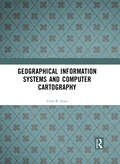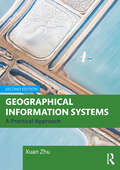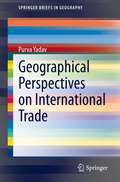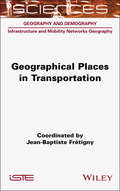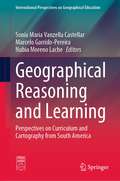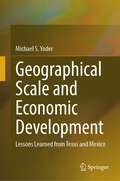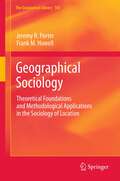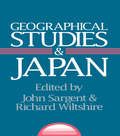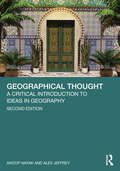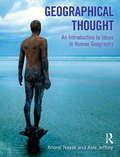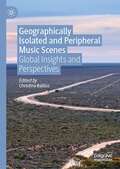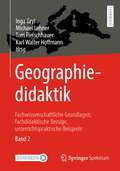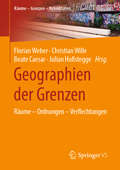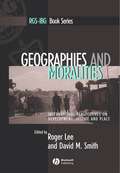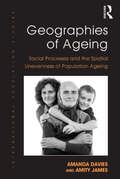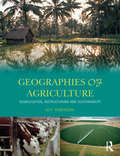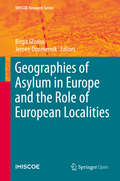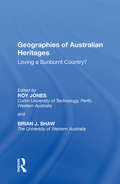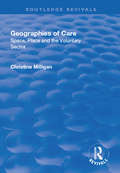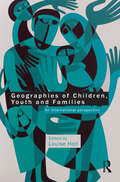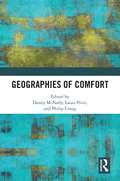- Table View
- List View
Geographical Indications of Indian Handlooms: Between Legal Right and Real Right
by Nidhi Buch Hetvi TrivediThis book presents a comprehensive analysis of Geographical Indications (GI) in the Indian context with particular reference to the handloom sector. It discusses themes such as the rationale of GI as IP (intellectual property); the domestic position on GIs; GI protection under various international instruments; handlooms from Gujarat and their GI journey; the efficacy of GIs; and GI structure for handlooms. The volume fills the gap between law and policies and recommends the implementation of an efficient legal system. It highlights the status of Indian handlooms, a sector that represents the country’s cultural heritage and supports a range of livelihoods. We examine India’s GI protection system with its diverse cultures and explore how GI can help recognize, support and promote these products to bring socio-economic benefits. The work documents policy measures undertaken for the revival, restructuring and promotion of Indian handlooms and handicrafts, and will serve as an important intervention in Indian law on GI. An investigative study that evaluates the current law and policy on GI protection through detailed case studies and empirical research on select Indian handlooms, this book will be useful to scholars and researchers of geography, economics, development studies, sociology, law and public policy. It will also interest policymakers, legal practitioners, textile and handloom professionals, design and business administration institutes, media, arts and crafts museums and civil society organizations working on handlooms or in intellectual property.
Geographical Information Systems In Archaeology
by James Conolly Mark LakeGeographical Information Systems (GIS) is a rapidly developing archaeological method which is moving from the domain of the computer specialist into that of the broader archaeological community. This comprehensive manual on the use of GIS in archaeology explores the concept of GIS and illustrates how it can be adapted for practical use. Examining issues such as spatial databases, data acquisition, spatial analysis, and techniques of visualization, the book is an essential tool for both students and professional archaeologists.
Geographical Information Systems and Computer Cartography
by Chris B. JonesA concise text presenting the fundamental concepts in Geographical Information Systems (GIS), emphasising an understanding of techniques in management, analysis and graphic display of spatial information.Divided into five parts - the first part reviews the development and application of GIS, followed by a summary of the characteristics and representation of geographical information. It concludes with an overview of the functions provided by typical GIS systems. Part Two introduces co-ordinate systems and map projections, describes methods for digitising map data and gives an overview of remote sensing. Part Three deals with data storage and database management, as well as specialised techniques for accessing spatial data. Spatial modelling and analytical techniques for decision making form the subject of Part Four, while the final part is concerned with graphical representation, emphasising issues of graphics technology, cartographic design and map generalisation.
Geographical Information Systems and Computer Cartography
by Chris B. JonesA concise text presenting the fundamental concepts in Geographical Information Systems (GIS), emphasising an understanding of techniques in management, analysis and graphic display of spatial information.Divided into five parts - the first part reviews the development and application of GIS, followed by a summary of the characteristics and representation of geographical information. It concludes with an overview of the functions provided by typical GIS systems. Part Two introduces co-ordinate systems and map projections, describes methods for digitising map data and gives an overview of remote sensing. Part Three deals with data storage and database management, as well as specialised techniques for accessing spatial data. Spatial modelling and analytical techniques for decision making form the subject of Part Four, while the final part is concerned with graphical representation, emphasising issues of graphics technology, cartographic design and map generalisation.
Geographical Information Systems: A Practical Approach
by Xuan ZhuGeographical information systems (GIS) are powerful tools for reporting on the environment, natural resources and social and economic development; modelling the environmental, biophysical, social and economic processes; assessing environmental and social impacts; evaluating environmental, social and economic policies and actions and dissimilating spatial information. Geographical Information Systems: A Practical Approach provides the fullest available introduction to GIS and their environmental, social and economic applications. This new edition has been substantially revised and updated to incorporate the key developments in GIS technology and spatial data science and their applications that have taken place in recent years.The key features include: A comprehensive coverage of concepts, methods, techniques and tools in GIS for spatial data capturing, processing, visualisation, analysis, modelling and decision-making Incorporation of advanced machine learning techniques for spatial data analysis and modelling Extended coverage of spatial visualisation with 3D mapping and online mapping Weaving together of GIS theory and practice to help readers learn important GIS concepts and methods and develop their understanding through practicals with ArcGIS Pro or QGIS New and updated case studies illustrating the innovative use of GIS for a wide range of applications The second edition of this text continues to bring up-to-date GIS knowledge, tools and practices into one cohesive, comprehensive, concise and self-contained book which is accessible to students, scientists and practitioners in environmental science, earth science, geography, archaeology and other scientific studies that have a spatial dimension.
Geographical Perspectives on International Trade (SpringerBriefs in Geography)
by Purva YadavThis book analyzes spatial and temporal patterns of international trade from a geographical perspective. Trade is an important key to understanding the changing dynamics of economic spaces over time. However, studies by geographers are largely confined to case studies, whereas the spatial dimension is often missing from the approach of economists. This study highlights spatial patterns and commodity composition of global trade and the nature of relationship between trade and other economic attributes. A case study of the MERCOSUR trade block examines inter-regional and intra-regional trade flows. The book captures a comprehensive picture of the structure of international exchange by using ample maps and illustrations as supporting features. Many different methods are applied such as the location quotient to capture concentration and diversification of commodity composition, data reduction techniques such as factor analysis and regression models for relating the economic structures and trade patterns as well as residual mapping among others. This book is a significant contribution to geographical, economical and social sciences research and very useful to graduate and post-graduate students as well as scientists of all related areas who have interest in exploring the changing dynamics of the global economy via trade flows. It provides a road map to further explore different dimensions of international trade and its role in understanding the transforming global economy.
Geographical Places in Transportation (ISTE Invoiced)
by Jean-Baptiste FretignyIn the entanglement of practices, protagonists, techniques and infrastructures that enable mobility, transportation places play a crucial role. While transportation is often approached through the prism of networks, Geographical Places in Transportation invites us to shift our focus toward the places that link transportation and facilitate the movements of people, objects and materials. Through the myriad activities that unfold there, transportation places play an active role in the interdependencies that shape our daily lives. This book looks at transportation production and experience sites as places–processes, where a considerable proportion of society’s challenges and the habitability of territories are at stake: ecological transition; social inequalities; roles of minorities and living beings; access to employment and other resources; role of atmospheres and ambiances; commercial strategies and security concerns; expansion of digital capitalism; and relations with both the near and the distant.
Geographical Reasoning and Learning: Perspectives on Curriculum and Cartography from South America (International Perspectives on Geographical Education)
by Sonia Maria Vanzella Castellar Marcelo Garrido-Pereira Nubia Moreno LacheThis book presents the distinctive theoretical and methodological approaches in geography education in South America and more specifically in Brazil, Chile and Colombia. It highlights cartography and maps as essential tools and provides a meaningful approach to learning in geographical education, thereby giving children and young people the opportunity to better understand their situations, contexts and social conditions. The book describes how South American countries organize their scholar curriculum and the ways in which they deal with geography vocabulary and developing fundamental concepts, methodologies, epistemological comprehension on categories, keywords and themes in geography. It also describes its use in teachers’ practices and learning progressions, the use of spatial representations as a potent mean to visualize and solve questions, and harnesses spatial thinking and geographical reasoning development. The book helps to improve teaching and learning practices in primary and secondary education and as such it provides an interesting read for researchers, students, and teachers of geography and social studies.
Geographical Scale and Economic Development: Lessons Learned from Texas and Mexico
by Michael S. YoderThis book is an attempt to bridge the academic discipline of economic geography with the professional field of economic development. Through case studies of economic development, it illustrates two fundamental concepts of the sub-discipline of economic geography: scale and spatial connections. It demonstrates some of the ways that economic development policies and plans are linked globally, nationally, regionally, and locally. It ties together several studies of communities and transportation systems in Texas and Mexico carried out from the late 2010’s through 2021. The studies shed light on the need to study economic development at multiple scales and to do so through blended qualitative research methods that include conversations with economic development stakeholders, published data, news content from the business and trade media, and direct observation of the built environment.The book is a set of narratives that combine descriptions of the evolution of commercial transportation systems, economic promotion in selected communities, and corresponding changes in the built environment. It is organized into three sections, each of which corresponds to a different scale at which economic development functions: macro, regional, and local.
Geographical Sociology: Theoretical Foundations and Methodological Applications in the Sociology of Location
by Frank M. Howell Jeremy R. PorterThe discipline of Sociology has a rich history of including spatial context in the analysis of social issues. Much of this history has revolved around the development and application of spatial theory aimed at understanding the geographic distribution of social problems, the organization of communities, and the relationship between society and the environment. More recently, the social sciences have seen a large number of technological innovations that now make it possible to place social behaviour in spatial context. Consequently, because of the historical disjuncture in the development of spatial theory and the recent development of relevant methodological tools, the relationship between materials describing both the methodological approaches and their theoretical importance a scattered throughout various books and articles. Geographical Sociology consolidates these materials into a single accessible source in which spatial concepts such as containment, proximity, adjacency, and others are examined in relation to such methodological tools as hierarchical linear models, point pattern analysis, and spatial regression. As these methods continue to increase in popularity among social scientists the ability to more generally understand societies relationship to geographic space will continue to increase in it importance in the field. This book represents a starting point to linking these concepts to practice and is presented in an accessible form in which students, researchers, and educators can all learn, and in turn, contribute to its development.
Geographical Studies and Japan
by John Sargent Richard WiltshireDescribes the trends, diversity and differences in Japanese and British geographical studies.
Geographical Thought: A Critical Introduction to Ideas in Geography
by Alex Jeffrey Anoop NayakThis new second edition of Geographical Thought remains a clear and accessible introduction to the key ideas and figures in human geography. A renewed focus on climate justice is layered throughout the book seguing into a new chapter on decolonising geography. Each of the chapters has been refreshed using the latest scholarship in the field, cutting-edge theory and contemporary case studies. From animal geographies to Black geographies, the current text is brimming with new theories, concepts and ideas.Across three distinctive parts ('Geographical Foundations', 'Geography at the Intersections' and 'Plural and Relational Geographies'), this book provides an essential introduction to the theories that have shaped the study of societies and space. Opening with an exploration of the founding concepts of human geography in the nineteenth-century academy, Nayak and Jeffrey examine the range of theoretical perspectives that have emerged within human geography over the last century from feminist and Marxist scholarship, through to postcolonial and non-representational theories. Each chapter contains insightful lines of argument that encourage readers towards independent thinking and critical evaluation. The supporting materials include a glossary, visual images, further reading suggestions and dialogue boxes.This book is an invaluable guide for students new to the discipline, seeking an introduction to the theories and ongoing debates, as well as those looking to deepen their understanding of human geography.
Geographical Thought: An Introduction to Ideas in Human Geography
by Alex Jeffrey Anoop NayakGeographical Thought provides a clear and accessible introduction to the key ideas and figures in human geography. The book provides an essential introduction to the theories that have shaped the study of societies and space. Opening with an exploration of the founding concepts of human geography in the nineteenth century academy, the authors examine the range of theoretical perspectives that have emerged within human geography over the last century from feminist and marxist scholarship, through to post-colonial and non-representational theories. Each chapter contains insightful lines of argument that encourage readers towards independent thinking and critical evaluation. Supporting materials include a glossary, visual images, further reading suggestions and dialogue boxes.
Geographically Isolated and Peripheral Music Scenes: Global Insights and Perspectives
by Christina BallicoThis book explores the influence of geographical isolation and peripherality on the functioning of music industries and scenes which operate within and from such locales. As is explored, these sites engage dynamic practices to offset challenges resulting from geographical isolation and peripherality.
Geographiedidaktik: Fachwissenschaftliche Grundlagen, fachdidaktische Bezüge, unterrichtspraktische Beispiele - Band 2
by Inga Gryl Michael Lehner Tom Fleischhauer Karl Walter HoffmannMit dem zweibändigen Werk liegt das erste deutschsprachige Lehrbuch zur Geographiedidaktik vor, welches konkret zum kreativen und praxistauglichen Verknüpfen von fachwissenschaftlichen und fachdidaktischen Bezügen anregt. Mit Hilfe eines „Didaktischen Mischpults“ sollen mannigfaltige didaktische Variations- und Kombinationsmöglichkeiten gelingen. Hierfür stehen neben dem klassischen Inhaltsverzeichnis fünf weitere Verzeichnisse zur Verfügung, die einen einfachen Zugriff auf die einzelnen Abschnitte der jeweiligen Beiträge (geographiedidaktische Bezüge, fachwissenschaftliche Bezüge, Basiskonzepte, Kompetenzen, räumliche Bezüge) ermöglichen und somit ein eigenständiges (Re-)Mixen erleichtern. Außerdem stehen zu vielen Beiträgen konkrete Arbeitsmaterialien und editierbare Druckvorlagen in einem digitalen Materialanhang bereit.Die Gesamtkonzeption des Werks betont die Interdisziplinarität des Fachs Geographie im Bezug zu Natur- und Gesellschaftswissenschaften und stellt die Verflechtung beider Bereiche als Normalfall dar. Mit Blick auf die fachwissenschaftlichen Bezugspunkte und die Orientierung in Lehrplänen werden in Band 1 naturwissenschaftliche und in Band 2 gesellschaftswissenschaftliche zentrierte Anwendungsbezüge dargestellt, aber stets mit interdisziplinären Bezügen im Bereich Mensch-Umwelt-System, da vor dem Hintergrund von Vernetzung und Komplexität keine scharfe Trennung möglich und sinnvoll ist. Beide Bände beinhalten zudem methodische Themen, die im Band 1 die technischen Grundlagen und im Band 2 die sozialgeographischen Implikationen in einer Kultur der Digitalität fokussieren.Die beiden Bände sind ein umfassendes Gemeinschaftswerk, das verschiedene Professionen und Expertisen vereint. Die 83 Autor*innen aus der gesamten deutschsprachigen Community der Geographiedidaktik sind in Schulpraxis, Lehramtsausbildung und/oder fachdidaktischer Forschung tätig. Leitend ist dabei eine theoretisch und empirisch fundierte, reflektierte Praxis. Damit richtet sich das Werk an Schulpraktiker*innen, Lehrer*innen, Referendar*innen, Studierende, Fachdidaktiker*innen, Lehramtsbildner*innen, Theoretiker*innen und Interessierte.
Geographien der Grenzen: Räume – Ordnungen – Verflechtungen (Räume – Grenzen – Hybriditäten)
by Florian Weber Christian Wille Beate Caesar Julian HollsteggeDer Sammelband diskutiert den Zusammenhang von Räumen, Ordnungen und Verflechtungen. Die Autor*innen aus den Raum-, Sozial- und Kulturwissenschaften wählen unterschiedliche Zugänge zu Grenzen und analysieren ihre (Re-)Produktionsprozesse als ‚Geographien der Grenzen‘. Dabei rücken sie auch andere als nationalstaatliche Grenzen in den Blick, wie zum Beispiel stadtlandhybride Differenzierungen. So wird in diesem Band aus verschiedenen theoretischen und thematischen Blickwinkeln der Frage nachgegangen, wie und welche ,Geographien der Grenzen‘ sich im Zusammenspiel von unterschiedlichen Destabilisierungen und (Re-)Stabilisierungen von Grenzen (re)konstruieren lassen.
Geographies and Moralities: International Perspectives on Development, Justice and Place (RGS-IBG Book Series #83)
by David M. Smith Roger LeeThis topical book addresses contemporary concern with the interconnections between geography and morality. Covers both the geographical context of morality, and moralities in geographical methods and practices. Contains up-to-date case studies based on original research. Deals with controversial issues, such as problems of globalization, European integration, human rights in Nigeria, territorial conflict in Israel, and land reform in post-apartheid South Africa. The editors are well-published leading international authorities. The contributors are drawn from Australia, Eastern Europe, Israel, South Africa, the UK and the US.
Geographies of Ageing: Social Processes and the Spatial Unevenness of Population Ageing (Perspectives On Rural Policy And Planning Ser.)
by Amanda Davies Amity JamesPopulation ageing is projected to affect all countries across the world in coming decades. The current rate of population ageing is unprecedented in human history with population projections indicating that this will be an enduring trend. Moreover, population ageing is spatially pervasive, affecting every man, woman and child. This has considerable implications for policy responding to the economic, social and healthcare outcomes of population ageing. The potential economic implications have been likened to those of the 2008 global financial crisis. This book examines the patterns and causes of uneven population ageing. It identifies those countries and localities most likely to experience population ageing and the reasons for this. Attention is also given to the role that youth migration, labour force migration, retirement migration and ageing in place have in influencing the spatial concentrations of older people. The book brings together a range of diverse international case studies to illustrate the importance of understanding the causes of population ageing. Case studies include a review of ageing in Florida's (USA) labour force, an investigation into the housing arrangements for the elderly in Northern Ireland and an assessment of the environmental stewardship activities of Grey Nomads on Western Australia's remote north coast.
Geographies of Agriculture: Globalisation, Restructuring and Sustainability
by Guy RobinsonAgricultural Geography has changed dramatically in recent decades, reflecting the transformation of the farming industry itself. Geographies of Agriculture embraces these changes, applying ideas and methods from contemporary social science, as it moves beyond farm-based production to address current issues affecting the production and consumption of food and fibre throughout the world. The book places special emphasis on topics that reflect globalisation processes, integration of agriculture into the wider agri-food system, concern with attaining sustainable production systems, and the importance of both government and supra-government policies. Examples are drawn from North America, Western Europe and the developing world. Geographies of Agriculture will appeal especially to Geography students, but should also be of interest to a broader range of students in Sociology, Economics and Development Studies, and anyone interested in agriculture, food production and consumption, and rural development.
Geographies of Asylum in Europe and the Role of European Localities (IMISCOE Research Series)
by Birgit Glorius Jeroen DoomernikThis open access book describes how the numerous arrivals of asylum seekers since 2015 shaped reception and integration processes in Europe. It addresses the structuration of asylum and reception systems, and spaces and places of reception on European, national, regional and local level. It also analyses perceptions and discourses on asylum and refugees, their evolvement and the consequences for policy development. Furthermore, it examines practices and policy developments in the field of refugee reception and integration. The volume shows and explains a variety of refugee reception and integration strategies and practices as specific outcome of multilevel governance processes in Europe. By addressing and contextualizing those multiple experiences of asylum seeker reception, the book is a valuable contribution to the literature on migration and integration, societal development and political culture in Europe.
Geographies of Australian Heritages: Loving a Sunburnt Country? (Heritage, Culture And Identity Ser.)
by Roy JonesIn any settler and/or postcolonial society, heritage is a complex and contested topic that involves indigenous, imperial and other migrant components. In Australia, this situation is compounded by the unique characteristics of the country's natural environment, the considerable diversity of its migrant intake and the demographic and technological imbalances between its indigenous and settler populations. This volume brings together internationally recognized academics and emerging scholars, whose expertise extends through the areas of tourism, planning, heritage management, environmental studies and state and local government. Through a representative set of case studies from across the country's states and capital cities, the contributors demonstrate the range and diversity of heritage issues currently confronting Australia, and consider possible ways of resolving these.
Geographies of Behavioural Health, Crime, and Disorder: The Intersection of Social Problems and Place (GeoJournal Library #126)
by Jayajit Chakraborty Kim M. LerschThis book focuses on the intersection of place and overall community health thereby focusing on some of the most critical contemporary social problems, including the opioid crisis, suicide, socioeconomic status and ethnicity, mental illness, crime, homelessness, green criminology, and social and environmental justice. Scholars from a variety of disciplines, including geography, sociology, criminology, mental health, social work, and behavioural sciences discuss the importance of geography in our quality of life. Each chapter introduces the reader to an overview of the topic, presents theoretical frameworks and the most recent empirical evidence, and discusses real world policy implications. As such this book is a key resource for researchers, policy makers, and practitioners working in the field.
Geographies of Care: Space, Place and the Voluntary Sector (Routledge Revivals)
by Christine MilliganThis title was first published in 2001. As care services in Britain have moved from institutional to community-based environments, there has been a simultaneous shift in those agencies concerned with the provision of such care and support. this new environment of care is a complex one, involving numerous different actors and agencies that operate across various different spatial and organizational levels of the policy process. The implementation and success of care policies depend in part on the inter-relationships between these various players. This book examines these inter-relationships, illustrated by an in-depth empirical study of policy makers and informal care providers concerned with the frail elderly in Scotland. Taking the voluntary sector as a lens through which these inter-relationships are explored, it analyzes how voluntary support is affected by differing local contexts of care and what this means in terms of locally based care outcomes.
Geographies of Children, Youth and Families: An International Perspective
by Louise HoltThis edited collection brings together international experts from the vibrant and growing field of geographies of children, youth and families. Designed as an introduction to the topic, this book provides an overview of current conceptual and theoretical debates surrounding geographies of children, youth and families, and gives a wide range of examples of cutting-edge research from a variety of national contexts across the globe. The theme of ‘disentangling the socio-spatial contexts of young people and/or their families’ advances debates in the field by emphasising the context of young people’s social agency. Geographies of Children, Youth and Families is an invaluable course text for undergraduate and postgraduate students of geography and the social sciences, as well as being of interest to students and practitioners of education, youth work, social policy, and social work.
Geographies of Comfort
by Danny McNally, Laura Price, and Philip CrangBringing together conceptual and empirical research from leading thinkers, this book critically examines ‘comfort’ in everyday life in an era of continually occurring social, political and environmental changes. Comfort and discomfort have assumed a central position in a range of works examining the relations between place and emotion, the senses, affect and materiality. This book argues that the emergence of this theme reflects how questions of comfort intersect humanistic, cultural-political and materialist registers of understanding the world. It highlights how geographies of comfort becomes a timely concern for Human Geography after its cultural, emotional and affective aspects. More specifically, comfort has become a vital theme for work on mobilities, home, environment and environmentalism, sociability in public space and the body. ‘Comfort’ is recognized as more than just a sensory experience through which we understand the world; its presence, absence and pursuit actively make and un-make the world. In light of this recognition, this book engages deeply with ‘comfort’ as both an analytic approach and an object of analysis. This book offers international and interdisciplinary perspectives that deploys the lens of comfort to make sense of the textures of everyday life in a variety of geographical contexts. It will appeal to those working in human geography, anthropology, feminist theory, cultural studies and sociology.


